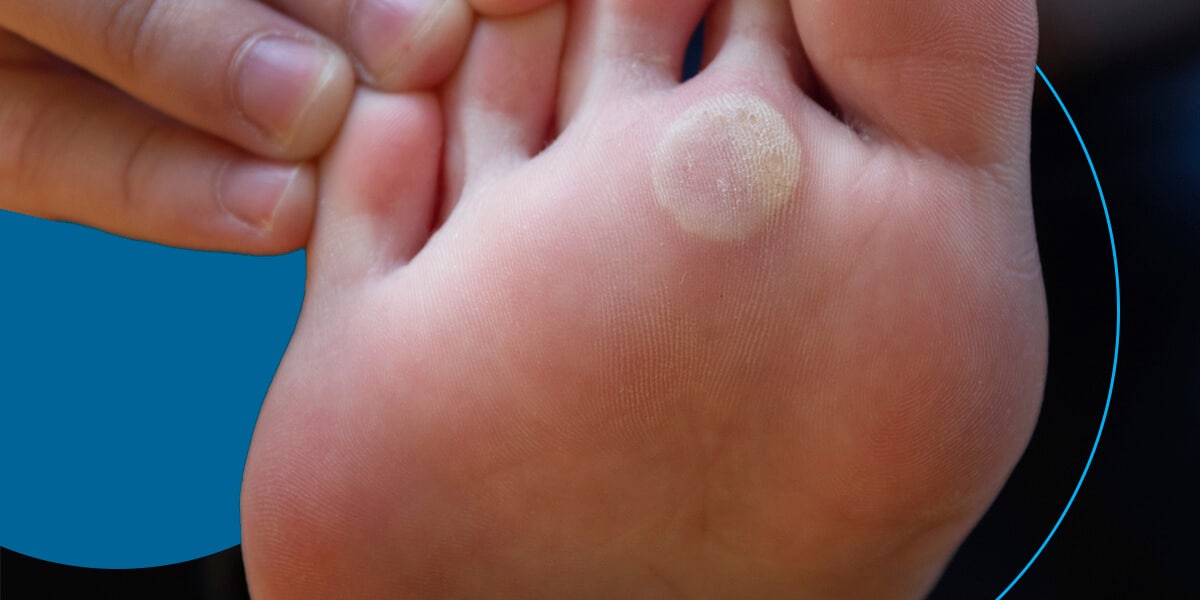Are you a health-conscious individual who loves swimming as a way to stay fit and unwind? Do you frequently visit your local swimming pool to get in your laps? If you’ve since experienced an unpleasant surprise — a small, painful growth on the sole of your foot — you might have contracted a plantar wart caused by the human papillomavirus (HPV).
As people become more aware of the potential risks associated with various environments, it’s crucial to shed light on one particular concern that swimmers may encounter — plantar warts. Swimming pools, known for their recreational and therapeutic benefits, can also serve as potential breeding grounds for HPV, leading to the development of these painful warts on the soles of our feet.
What’s a Plantar Wart?
Plantar warts, also known as tinea pedis, are a common and often bothersome skin condition that can affect anyone, particularly those who spend time in communal areas such as swimming pools. These warts develop on the soles of the feet, specifically on the weight-bearing areas like the heels or balls of the foot. While they may appear harmless initially, plantar warts can cause discomfort and inconvenience if left untreated.
Plantar warts are caused by HPV, which enters the body through minor cuts or abrasions on the skin. Once the virus infects the outer layer of the skin, it triggers the rapid growth of cells, leading to the development of a wart. Unlike other types of warts that may appear on the hands or face, plantar warts grow inward due to the pressure applied while walking or standing. As a result, they can become embedded deep within the skin, causing pain and tenderness.
Are Plantar Warts the Same as Athlete’s Foot?
No, a plantar wart is not a type of athlete’s foot. Athlete’s foot is a fungal infection. The fungus causes itching, redness and peeling. A plantar wart is a viral infection caused by HPV that results in a wart on the sole of the foot. While both athlete’s foot and plantar warts can affect the feet, they are caused by different pathogens and require different treatment approaches.
How Do You Get Plantar Warts From Swimming Pools?
It’s important to note that plantar warts are highly contagious. The virus thrives in warm, moist environments, making swimming pools a breeding ground for it. Walking barefoot in such areas increases the risk of contracting the virus and developing plantar warts.
Here are some ways individuals can contract plantar warts from swimming pools:
- Direct contact: When an infected individual with a plantar wart walks barefoot on pool decks, locker room floors or communal shower areas, they can shed the virus onto the surfaces. Subsequently, an unaffected person who walks on these contaminated surfaces can pick up the virus through their skin.
- Wet and warm environment: The combination of water and high foot traffic provides the perfect conditions for spreading the virus. Additionally, the virus can survive on surfaces for extended periods.
- Lack of foot protection: Walking barefoot in pool areas is a common practice for many swimmers, leaving their feet vulnerable to infection.
- Sharing personal items: Towels, flip-flops or pool toys that have been in contact with an infected person’s feet can harbor the virus. If others use these items without proper disinfection or hygiene practices, they can inadvertently expose themselves to the HPV virus.
How Do You Know You Have a Plantar Wart?
Plantar lesions typically have a rough, grainy texture and may appear gray or brown with small black dots, known as “wart seeds.” Sometimes, the wart may develop a callus-like covering, further exacerbating the discomfort.
Here are some signs you may have a plantar wart:

- Raised and rough surface: Plantar warts typically have a raised rough surface. They may appear grainy or have a cauliflower-like texture. The unevenness of the wart is caused by the rapid growth of cells triggered by the HPV infection.
- Discoloration: Plantar warts often have a different color than the surrounding skin. They can appear gray, brown or yellowish. The coloration may vary depending on the individual and the stage of the wart’s development.
- Wart seeds: If you closely examine a plantar wart, you may notice small black dots within it. These “wart seeds” are clotted blood vessels. These seeds may become more visible when the wart is scraped or filed.
- Pain or tenderness: Plantar warts can cause discomfort or pain, especially when pressure is applied to them. The pain may feel like a sharp, burning sensation or simply tenderness.
- Callus-like formation: This can make it more challenging to identify the wart itself. The callus is a protective response to the pressure exerted on the wart. However, beneath the callus, the wart is still present and continues to grow.
Preventing Plantar Warts in Swimming Pools
When it comes to enjoying your time in swimming pools while minimizing the risk of contracting plantar warts, preventive measures can protect you and help you maintain optimal foot health:
- Practice good foot hygiene: Before and after swimming, thoroughly wash and dry your feet. Pay special attention to the areas between your toes, as moisture can accumulate there.
- Wear waterproof footwear: Slippers, flip-flops or pool shoes act as a barrier between your feet and the potentially contaminated surfaces.
- Maintain proper pool hygiene: Ensure that the pool you frequent follows appropriate chlorination and disinfection protocols. Well-maintained pools with proper water chemistry help reduce the survival of the HPV virus, making it less likely to be present in the environment.
- Regularly inspect your feet: Early detection of any suspicious growths or changes can allow for prompt intervention and prevent the spread of plantar warts.
Plantar Wart Treatment
Planter warts are common and affect 10% of the population. If you suspect you have a plantar wart, it is advisable to consult a health care professional for a proper diagnosis. They can examine the affected area, assess the characteristics of the growth and provide appropriate treatment recommendations.
There are various treatment options available to help manage and eliminate the wart. A pharmacist can provide over-the-counter treatments that you use to treat plantar warts. These typically include topical medications containing salicylic acid. These medications work by gradually removing the layers of the wart over time. It’s important to carefully follow the instructions provided with the product and continue treatment for the recommended duration.
Plantar warts can sometimes be stubborn and take time to resolve fully. If you have concerns or if the wart persists despite treatment attempts, it is advisable to seek medical advice from a podiatry professional.
Reach Out to Foot & Ankle Surgical Associates for Help With Plantar Warts
Seek professional help from specialized health care providers offering valuable expertise and guidance. Foot & Ankle Surgical Associates is a team of experienced podiatrists and foot and ankle surgeons specializing in diagnosing and treating various foot conditions, including plantar warts. Our expertise and comprehensive approach to foot health make us an excellent choice for individuals seeking professional assistance.
Each individual plantar wart case is unique. Foot & Ankle Surgical Associates takes a patient-centered approach, carefully assessing the specific characteristics of the wart and considering the patient’s medical history and lifestyle factors. Based on this thorough evaluation, we develop tailored treatment plans that address each patient’s needs and goals.
At Foot & Ankle Surgical Associates, patient care and satisfaction are our top priorities. Our team is known for their compassionate and supportive approach, ensuring that patients feel comfortable, well-informed and actively involved in their treatment journey.
Don’t let plantar warts interfere with your comfort and mobility any longer. Take control of your foot health by contacting Foot & Ankle Surgical Associates today.






